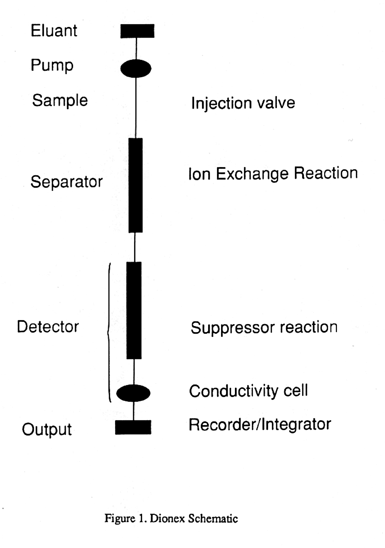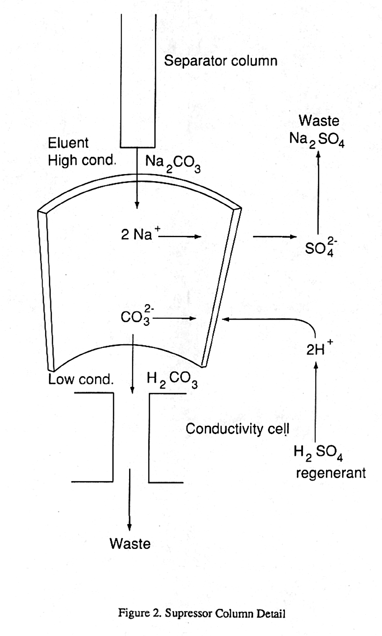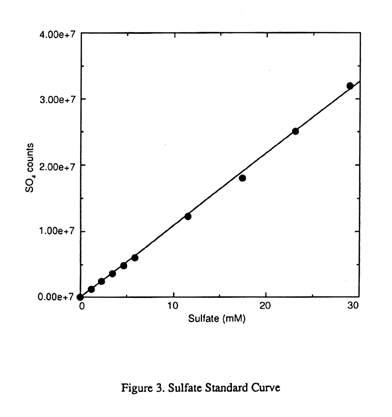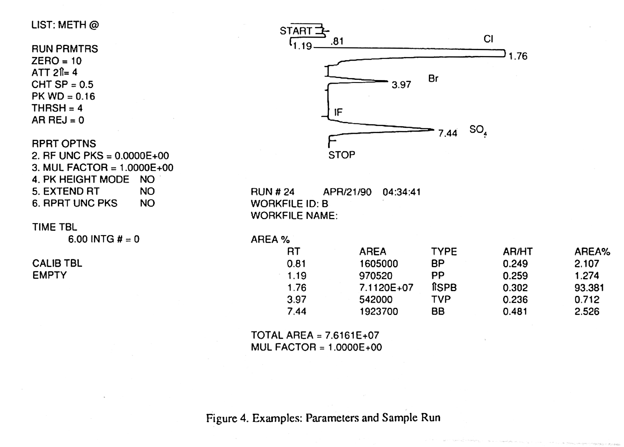

The use of this method allows quick determination of the alkalinity very shortly after completion of the pore-water extraction. The titrated sample can be used for many subsequent analyses, provided the dilution caused by the addition of 0.1 M HCl is properly accounted for through the use of a dilution factor. It should, however, be noted that subsequent analysis of potassium may be somewhat suspect because of the use of saturated KCl in the reference electrode.
F = (v + V0) x 10E/A,
where: F = Gran factor, v = volume of acid added to the solution in the titration vessel; V0 = original volume of the sample; E = EMF (millivolts) at v; A = slope of electrode determined on the basis of the electrode calibration. Usually the slope is about 59 mV at 25o C, but it can be determined from the electrode calibration.Of some interest is that the function, F, when plotted as a function of the volume of acid added (v), is linear when obtained sufficiently far removed from the equivalence point. With the combination microelectrodes at hand, this range stretches from 220 mV to 240 mV. For these reasons the computer is directed to use this EMF range in the evaluation of the equivalence point. In the absence of a computer plot of F vs. v, it may be advisable for the operator to take one or two sets of data and plot F vs. v. If anything, this will instill confidence in the method by the analyst in charge of the titration. The value of v at F = 0 is the equivalence point from which the alkalinity can be evaluated.
The slope of the F vs. v plot changes with a variation in the sulfate content of the samples. This is because at lower pH values the reaction
H+ + SO42- = HSO4-
plays an important role in establishing the pH of the solution through a buffering effect. This change in slope, however, has no effect on the GRAN extrapolation intercept with the y-axis, as demonstrated by Gieskes and Rogers (1973). The slope change, however, is not accurate enough to estimate sulfate concentrations.
The nature of the automatic operation of the titrator is described in the appropriate shipboard manual.
The KCl solution serves as an ionic-strength preserver and does
not affect the alkalinity. Preference should be given to the borax standard,
followed by the bicarbonate and carbonate standards respectively. Good
agreement among all standards instills good confidence.
Often, especially in continental-margin zones, very high alkalinities may occur. Thus, for instance, in a sample of 100 mM alkalinity it will require about 5 cm3 of acid to titrate 5 cm3 of sample. This is not a major problem, but of course the original concentrations of other dissolved ions have halved in that case. If alkalinities much higher than 100 mM are expected, it would be preferable to titrate only 2 or 3 cm3 of sample, provided the electrodes can still be inserted into the solution.
Under all circumstances the total volume of acid added to the sample aliquot (record the size of the aliquot also) must be recorded on the storage vial so that future workers on the sample are alerted to the dilution factor to be used in the calculation of original concentrations.
Note that for the HCl, use must be made of ultrapure HCl. Normal (reagent grade) 0.1 M HCl can have a significant amount of iodide (~100-300 mM) in it, which can easily be avoided by using triple distilled ultrapure HCl.
It is of great importance to calibrate the 5 cm3 and 3 cm3 pipettes with distilled water and to note their precise volumes. The volumes should remain fixed for the duration of the cruise. They are important for establishing the dilution factor to be used for further work on the samples. The standardization of the acid, of course, takes account of the volumes.
1. Make a ~0.7 M KCl solution: 52 g KCl in 1000 cm3 of nanopure water.
2. Make a solution of 38.1 g of Na2B4O7.10H2O in 1000 cm3 nanopure water (0.1 M).
3. Take 20 cm3 of borax solution (2) and dilute to a total volume of 100 cm3 with the KCl solution. The KCl serves to make the solution of approximately the same ionic strength as seawater (in this case an ionic strength of about 0.56 M; seawater has an ionic strength of ~0.7 M). The alkalinity of this solution is 40 mM.
With the 5 cm3 sampling pipette, transfer 5 cm3 of this borate standard solution into the titration vessel. Titrate and evaluate the alkalinity with the presently available program (omitting the IAPSO correction-factor step). This titration will yield an alkalinity that is probably not quite equal to 40 mM, for the following reasons:
(a) The volume of the pipette is not quite equal to 5 cm3,
and
(b) the acid molarity of the 0.1 M HCl solution is not quite equal
to 0.1 M.
Now, from the estimated alkalinity and the actual alkalinity, calculate a calibration factor that goes in the program, much like the previous factor that adjusted for the IAPSO "alkalinity." In a way, that factor also adjusted for the difference in volume, although this fact was not known. Of course this necessitates the creation of different correction factors for a 3 cm3 or a 10 cm3 sample because of differences in true volumes. For these reasons I suggest the following program modifications:
1. Make the program easily accessible to the input of the calibration factor.
2. At the beginning of the cruise, calibrate with three different-sized pipettes, say of 3, 5, and 10 cm3. The volumes of these pipettes should not be changed from then on (tape them up). Work out the calibration factors for each of the pipettes and put them into the program in conjunction with the volume size command now used.
3. Make some extra standards of different alkalinities over the range of interest to serve as a double check. Weighing these standards presented no problems on the ship, and we obtained very good results during Leg 131.
Determination of sulfate is routinely carried out by means of the DIONEX ion chromatograph, which uses a small amount of sample and provides very reproducible results. However, if a quick semiquantitative estimate of dissolved sulfate is needed an alternate method can be used which involves the precipitation of sulfate in an excess of BaCl2. A comparison of the degree of cloudiness can be used as a qualitative estimate. Stabilization of the suspension with glycerol can, in principle, be used for a semiquantitative estimate of dissolved sulfate (see below).
The operation of the DIONEX ion chromatograph is discussed in detail in the operations manual on board ship. In this section only a brief description of the method is presented.
Although each individual user of the DIONEX system should consult the operations manual in detail, it may be useful to reiterate the principle of operation. Details of the theory can be found in Weiss (1986). Figure 1 (from Weiss, 1986) shows the following flow diagram:
1. The mobile phase is pumped through the system by means of a double reciprocating pump that allows for a pulse-free flow.
2. The sample is introduced through a loop injector and swept to the column by the mobile phase (the eluant) in which the ion exchange reactions separate the various anions (Cl-, Br-, SO42-) into separate waves, which then arrive at the detector as the sodium salts (the eluant consists of Na2CO3/NaHCO3).
3. The first part of the detector system (Fig. 2) consists of the suppressor, which consists of a semipermeable membrane. The solution from the separator column runs through the interior of the membrane fiber, whereas a dilute acid (H2SO4) runs countercurrently in contact with the exterior of the membrane. This allows H+ ions to be exchanged across the semipermeable membrane in exchange for Na+ ions. This, in turn, converts the greater conducting HCO3- and CO32- ions into less conducting H2CO3, and the less conducting sodium salts of Cl-, Br-, and SO42- are converted into their greater conducting acids.
4. The final solution then enters the conductivity cell, which records the conductivity of the "wave." This conductivity is proportional to the concentration of the ion at low concentration levels.


The seawater dilution standards will also serve as standards for potassium and sodium analysis by atomic emission spectroscopy, as will be discussed in the sections on these cations.
Though for the actual methodology we refer to the special DIONEX manual on board ship, it is important to stress some aspects of sample methodology here.
Under circumstances of normal interstitial-water recovery, we suggest using a dilution of 0.25 cm3 of sample to 50 cm3 with nanopure water.
When very low sulfates occur, a lesser dilution can be used, but it will be advisable to make a set of low sulfate standards using a similar dilution procedure. One more important aspect is that in order to assure continuous monitoring of the potential drift in the measurements, standards bracketing the range of expected sulfate concentrations (low SO4, low standard; high SO4, high standard) are measured during the sulfate run at a rate of one standard after each four samples. With the automatic sample changer, this is not a serious problem.
Diluted samples should be stored carefully (all samples stored in plastic polyethylene bottles) for future use in the analysis of sodium and potassium (see also above).


The nephelometric method for the determination of dissolved sulfate has been used for a number of years in freshwater research. It is based on the precipitation of barium sulfate by the addition of an excess of BaCl2 solution to a sample aliquot. In freshwater research the precipitation was effected by means of the addition of well-defined grain-sized barium chloride crystals, but the addition of a 0.25 M solution of BaCl2 to the test solution seems to suffice if a precision of ~1 mM is desired. In the method described below a few drops of glycerol are added in order to enhance the viscosity of the solution, which in turn keeps the suspension of BaSO4 in a better condition. We emphasize that this method is semiquantitative in nature, but it can be used for the following purposes:
1. The determination of dissolved sulfate in pore-water samples in case of failure of the DIONEX analyzer.
2. The determination of dissolved sulfate on an ad-hoc basis to determine sulfate concentrations on selected samples from pore waters in order to establish the concentration range of samples.
3. Any routine checks on water quality of drilling fluids, potable water, etc.

One (1) cm3 of nanopure water is added to a 10 cm3 glass vial with a snap cap. Add 0.1 cm3 (or any other appropriate amount) of sample or standard to the vial, followed by three drops of glycerol. Then add 3 cm3 of the BaCl2 solution. Set the spectrophotometer at 400 nm and read the absorbance. Plot the absorbance vs. standard curve.
Figure 5 below indicates that there is no exact linear fit and that the accuracy suffers somewhat at higher concentration levels. Nevertheless, reproducibility is quite good. The low-concentration-range samples still show a reasonable precision.
Below we document an even better nephelometric method for sulfate determination. The method uses a better stabilization of the barium sulfate suspension. The details were provided through the courtesy of Dr. Rick Jahnke.
2. Add 500 L of 1M HCl.
3. Add 40 L of sample or standard.
4. At precise 1 or 1.5 minute intervals, add 500 L of Ba/Gelatin reagent; mix gently.
5. After 30 minutes plus/minus 10-15 seconds, read turbidity in spectrophotometer at 420 nm.
Note: If reagent is added at 1.5 minute intervals, samples can be read at the same intervals 30 minutes later. It is an easier time limit to adhere to. Modify method as convenient. For lower sulfates, of course, one can use larger aliquots with matching standards. Also, use IAPSO standard seawater and dilution thereof as extra standards.
A good stock solution will be 6.183 g of boric acid in 1 dm3
of nanopure water (=100 mM).
2. Add 0.1 cm3 curcumin reagent.
3. Add 0.4 cm3 acid reagent (with repipet), mix on vortex mixer, and wait for at least 30 minutes.
4. Add 2.0 cm3 ammonium acetate-acetic acid buffer and mix.
5. Measure absorbance at 555 nm in a 1 cm cell after 1.5 hours.
6. Standard solutions should be run at the same time as the samples.
7. Make a standard curve. If linear, read concentrations directly. If curved, use lower concentration range of final solution.
CAUTION: If a crystalline precipitate forms after addition of the buffer (Step 4) it may be necessary to use slightly less buffer, e.g., 1.9 cm3 (by trial and error).
2. Add 1 cm3 acetate buffer.
3. Add 0.04 cm3 bromine water (fresh), mix on vortex mixer, and gently heat on hot plate for ~5 minutes (do not boil).
4. Allow to cool and add 0.1 cm3 of a 10% Na-azide solution (optional--if you fear NO2 is present, this will kill the NO2).
5. After cooling to room temperature, add 0.04 cm3 formic acid and mix on vortex mixer.
6. Add 0.03 cm3 of 10% KI and 0.5 cm3 sulfamic acid solution and mix on vortex mixer.
7. Measure absorbance at 355 nm in 1 cm cell 3 minutes (±5 seconds) after KI is added.
8. Standards should be run at the same time as samples, using same aliquots.
9. Make a standard curve; if linear, you can read the I concentrations directly. If curved, use lower concentration range of final solution.
STANDARDS: Use 0, 500, 1000, 1500, 2000 mM NaBr solutions and IAPSO (860 mM) as standards.
Procedure
1. Add 1.5 cm3 of phosphate buffer into a 5 cm3 glass vial.
2. Add 1.0 cm3 of distilled water.
3. Pipette a sample aliquot 25 to 100 mL (wash the tip of pipette with (1.+2.) solution several times).
4. Add 0.25 cm3 sodium hypochlorite solution.
5. Heat the solution on a hot plate and boil for about 5 seconds.
6. Remove from the hot plate and add 0.5 cm3 sodium formate solution and cool down to room temperature.
7. Add 0.03 cm3 of molybdate solution.
8. Add 0.05 cm3 of 10% KI solution (fresh daily).
9. Add 0.3 cm3 of sodium thiosulphate solution and 0.75 cm3 of sulfuric acid.
10. Measure absorbance at 355 nm in 1 cm cell 10 minutes after sulfuric acid is added (wait about 1 minute after sucking the solution into the cell, then write down the reading of absorbance).
11. Standard solutions should be run at same time as samples using same aliquots.
12. Make a standard curve; if linear, you can read the Br concentrations directly. If curved, use lower concentration range of final solution or adjust the added amount of sodium thiosulphate solution. Note: Please do not forget to correct for the iodide content; this method determines total I + Br.
The methodology is based on the method of Solorzano (1969), originally developed to detect very small NH4+ concentrations in seawater. Although blank problems in seawater are enormous, the relatively high concentrations in pore fluids (up to 85 mM in Leg 112 samples; Kastner et al., 1990) reduce this blank problem. In areas of slow sedimentation, however, very low ammonium concentrations require great caution to avoid this problem. The method is based on the diazotization of phenol and the subsequent oxidation of the diazo compound by chlorox to yield a blue color.
Care should be taken to use clean glass vials, preferably not used for Si and PO4 determinations, in which ammonium molybdate is used as a reagent.
Use a 100 lambda (100 microliters) Eppendorf pipette to transfer 0.1 cm3 of sample to a 5 cm3 glass vial. Add 1 cm3 nanopure water to each, then 0.5 cm3 phenol-alcohol solution, 0.5 cm3 sodium nitroprusside, and finally 1 cm3 of oxidizing solution. Adding these solutions with Eppendorf pipettes is fast and convenient and ensures proper mixing during addition. Shake samples after each addition. Standards should range from 0 to 1000 mM, or any other appropriate range as discussed above. Let the color develop for at least 1 hour (longer would be better, up to 3 hours) and then determine the absorbance at 640 nm wavelength.
The method is based on the production of a yellow silicomolybdate complex and the subsequent reduction of this complex to yield a blue color. The blue complex is very stable, which will enable delayed reading of the samples.
PRIMARY STANDARD: Dissolve 0.5642 g of Na2SiF6 in a 1 dm3 polyethylene volumetric flask. Dissolution is slow, so allow at least 3 minutes. This cannot be rushed. Use nanopure water for this purpose. The concentration of the standard is 3000 mM. Store in a 500 cm3 polyethylene bottle. The standard is stable indefinitely.
DILUTIONS FROM PRIMARY STANDARD: When making dilutions, use distilled water and store in polyethylene containers. Using a 50 cm3 volumetric flask, add the following amounts of primary standard and then bring to a total of 50 cm3:
30 µM Si 0.5 cm3 primary standard 60 1.0 120 2.0 240 4.0 360 6.0 480 8.0 600 10.0 900 15 1200 20 et cetera
2. Label and set up 3-dram plastic vials and caps (well washed with nanopure water).
3. Measure into the vials 4.0 cm3 of silica free nanopure water (3.8 cm3 for standards and blank).
4. For standards and blank only, pipette in 0.2 cm3 of synthetic seawater.
5. Pipette 0.2 cm3 of sample or standard or blank (nanopure water) into the vial with an Eppendorf pipette.
6. Record time.
7. Add 2.0 cm3 of molybdate solution to the vials. A yellow color will develop, and this is allowed to mature for exactly 15 minutes (±15 seconds). Then add 3.0 cm3 of the reducing solution. Cap the vials and let stand for at least 3 hours.
8. Read absorbances on the spectrophotometer at 812 nm. Please consult procedural notes of the following page.
Notes:
Do not handle more than about 30 samples at a time in order to ensure that the 15- minute time limit can be adhered to. Make sure that there are no wild fluctuations in room temperature, which is not normal in an air-conditioned room.
Do not use synthetic seawater in dilutions of the primary standard. This could cause the decrease in reactive silica in a few hours as a result of polymerization reactions.
The reason for adding 0.2 cm3 of synthetic seawater to the standards is to maintain a reasonably uniform salt content in relation to the samples, thus suppressing a potential salt effect on the method.
Although it is suggested that strict adherence to the 15-minute time limit is advisable, tests have shown that there is some leeway, i.e., the yellow molybdate complex is stable from 10 to 20 minutes. However, consistency in the time limit will eliminate any potential error.
It is important to wait at least 3 hours for the blue color to develop; the higher the concentration, the longer the time. The color remains stable for many more hours, and reading after 4 or 5 hours may, in fact, be a good idea. Again, consistency in time limits is advisable.